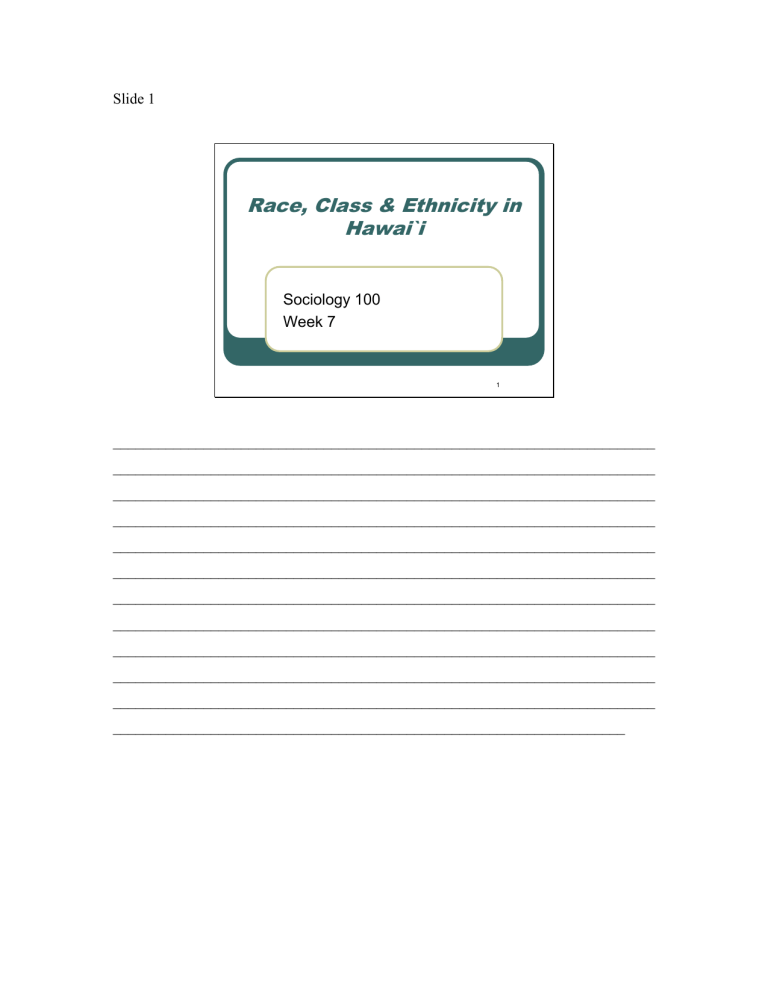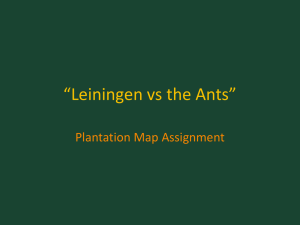Week Seven (Feb. 23)
advertisement

Slide 1 Race, Class & Ethnicity in Hawai`i Sociology 100 Week 7 1 ________________________________________________________________________ ________________________________________________________________________ ________________________________________________________________________ ________________________________________________________________________ ________________________________________________________________________ ________________________________________________________________________ ________________________________________________________________________ ________________________________________________________________________ ________________________________________________________________________ ________________________________________________________________________ ________________________________________________________________________ ____________________________________________________________________ Slide 2 Immigration Mahele (1848) made land available to foreigners Growth of sugar plantations increases after 1876 trade agreement opening U.S. markets. Need for cheap labor led to the importation of contract workers (Asia, Europe, Americas) 2 ________________________________________________________________________ ________________________________________________________________________ ________________________________________________________________________ ________________________________________________________________________ ________________________________________________________________________ ________________________________________________________________________ ________________________________________________________________________ ________________________________________________________________________ ________________________________________________________________________ ________________________________________________________________________ ________________________________________________________________________ ____________________________________________________________________ Slide 3 Immigration to Hawai‛i during the Plantation Era Immigrant Group Migration Era Family and Social Structure Role on Plantation Notes Kanaka Maoli 400 – 1200 A.D. Indigenous people; extended families Negligible Low numbers made their role on plantation marginal. Haoles Late 1700s – 1800s Variety of family arrangements; sometimes intermarried with kanaka maoli. Owners of plantations (especially descendants of missionaries); achieved dominance in economics & politics. Acquired economic and political power, especially through ties to the United States. Chinese Early 1800s; especially after the 1850s. Chinese immigration restricted during & after 1880s Came as single men. Some intermarried with Hawaiian women. Became the first specialists in manufacturing sugar. Primarily served as lowskilled laborers on the plantation until excluded in the 1880s & 1900. Chinese population in Hawai‛i grew to 18,000 by the 1880s. After restrictions on immigration in the 1880s and Chinese Exclusion Act (applied in Hawaii in 1900), Chinese left Hawaii in large numbers. Of those who remained, many opened businesses and established families, entering the professions in the 1900s. Portuguese 1878 – 1890s Came as families but often intermarried with Hawaiian women. Worked as foremen or “lunas” on the plantation Tended to stay with the plantation Scots 1880s-1890s Came as families or single men Worked as managers, engineers, & in skilled trades Worked in upper levels of plantation hierarchy; also worked as professionals. Japanese Came in small numbers in 1868, in growing numbers after 1880 Came initially as single males; later imported wives as “picture brides”, especially after 1908. Tended not to intermarry with other groups. Came primarily as contract workers (prior to 1900) to do field work. The Japanese migrated from southwest Japanese (Hiroshima, Yamaguchi, Fukuoka, Kumamoto). Many new residents remained in Hawaii after working on the plantation, entered business or trades and educated their children. Attained political prominence after WW II. 3 ________________________________________________________________________ ________________________________________________________________________ ________________________________________________________________________ ________________________________________________________________________ ________________________________________________________________________ ________________________________________________________________________ ________________________________________________________________________ ________________________________________________________________________ ________________________________________________________________________ ________________________________________________________________________ ________________________________________________________________________ ____________________________________________________________________ Slide 4 Puerto Ricans 1900 Came primarily as single men. Already diverse in ancestry, they tended to intermarry with Hawaiians, Spaniards, and Fillipinos. Came as agricultural workers; many remained in plantation communities. Also a colonized group (by Spanish) and U.S. after Puerto Rico was acquired as a result of the Spanish American War in 1898. Koreans 1903 Came initially as single men; some brought wives or imported wives. Came as immigrant workers Many immigrants were Christian, although few were originally from agricultural backgrounds. Blacks Early 1800s (as crew members on ships). Puerto Ricans of African ancestry came in 1901. Came as single males; some intermarried with Hawaiians (especially Black Portuguese from Cape Verde Islands). Planters rejected slavery as non-economical. Blacks often came as Puerto Ricans working as field laborers. Some opened businesses during Kingdom period. Very low numbers entered the Islands until coming as members of the armed services during Territory Period (1900-1959). Filipinos Came in numbers after 1906 Came as single men from Luzon, Cebu, Mindinao & other provinces. Worked as field hands; slow to urbanize. Philippines became a possession of the U.S. in 1898. Many Filipinos left Hawai‛i to return to Philippines or on to the continental United States Other Pacific Islanders 1850s Recruited as single men and families from Micronesia, Polynesia, Melanesia. Did not adapt well to plantation life. Many of the original settlers returned to their homes. 4 ________________________________________________________________________ ________________________________________________________________________ ________________________________________________________________________ ________________________________________________________________________ ________________________________________________________________________ ________________________________________________________________________ ________________________________________________________________________ ________________________________________________________________________ ________________________________________________________________________ ________________________________________________________________________ ________________________________________________________________________ ____________________________________________________________________ Slide 5 Imported Labor Planters looked to Asia as a source of cheap labor Contract labor (until 1900). Court-enforced contracts (Ha`alele Hana) Workers lived on site, in segregated camps Stratified plantation workforce wages by race Separation of the “races” common on plantations during 1800s/early 1900s 5 ________________________________________________________________________ ________________________________________________________________________ ________________________________________________________________________ ________________________________________________________________________ ________________________________________________________________________ ________________________________________________________________________ ________________________________________________________________________ ________________________________________________________________________ ________________________________________________________________________ ________________________________________________________________________ ________________________________________________________________________ ____________________________________________________________________ Slide 6 The Social Construction of Race Race is a sociocultural rather than a biological construct Prejudice – negative attitudes toward a category of people Stereotypes – overgeneralizations about a category of people 6 ________________________________________________________________________ ________________________________________________________________________ ________________________________________________________________________ ________________________________________________________________________ ________________________________________________________________________ ________________________________________________________________________ ________________________________________________________________________ ________________________________________________________________________ ________________________________________________________________________ ________________________________________________________________________ ________________________________________________________________________ ____________________________________________________________________ Slide 7 Ethnic identity in Hawai`i Ethnic identity is complex and fluid. People may identify with one or more ethnic groups Ethnic/racial categories have different meanings compared to other places. History and conflict shape social identity 7 ________________________________________________________________________ ________________________________________________________________________ ________________________________________________________________________ ________________________________________________________________________ ________________________________________________________________________ ________________________________________________________________________ ________________________________________________________________________ ________________________________________________________________________ ________________________________________________________________________ ________________________________________________________________________ ________________________________________________________________________ ____________________________________________________________________ Slide 8 Plantation Work & Identity Workforce organized around cultivation of cane and manufacture of sugar. Pidgin – Hawaiian Creole English – allowed communication. Newer, non-white ethnic groups occupy inferior positions; European workers occupy better positions. Construction of “race” influenced by plantation economy Racial stereotypes in Hawai`i derive from plantation history. 8 ________________________________________________________________________ ________________________________________________________________________ ________________________________________________________________________ ________________________________________________________________________ ________________________________________________________________________ ________________________________________________________________________ ________________________________________________________________________ ________________________________________________________________________ ________________________________________________________________________ ________________________________________________________________________ ________________________________________________________________________ ____________________________________________________________________ Slide 9 Worker Resistance & Local Culture Labor unions were first organized by ethnicity Planter response was pitting one group against another. As worker demands grew, planters responded with better conditions & pay (paternalism). Eventually, workers overcame racial barriers & united – acquired class consciousness. Separate racial identities merged into “local” identity as a result of the united labor movement during mid 1900s. 9 ________________________________________________________________________ ________________________________________________________________________ ________________________________________________________________________ ________________________________________________________________________ ________________________________________________________________________ ________________________________________________________________________ ________________________________________________________________________ ________________________________________________________________________ ________________________________________________________________________ ________________________________________________________________________ ________________________________________________________________________ ____________________________________________________________________ Slide 10 Hawai`i: Melting Pot or Salad Bowl? Class structure intersects with ethnicity (reflects plantation structure). Assimilation – adoption of dominant cultural traits/values Accommodation - coexistence Resistance – rejection of dominant values Pluralism – diversity with social parity 10 ________________________________________________________________________ ________________________________________________________________________ ________________________________________________________________________ ________________________________________________________________________ ________________________________________________________________________ ________________________________________________________________________ ________________________________________________________________________ ________________________________________________________________________ ________________________________________________________________________ ________________________________________________________________________ ________________________________________________________________________ ____________________________________________________________________






